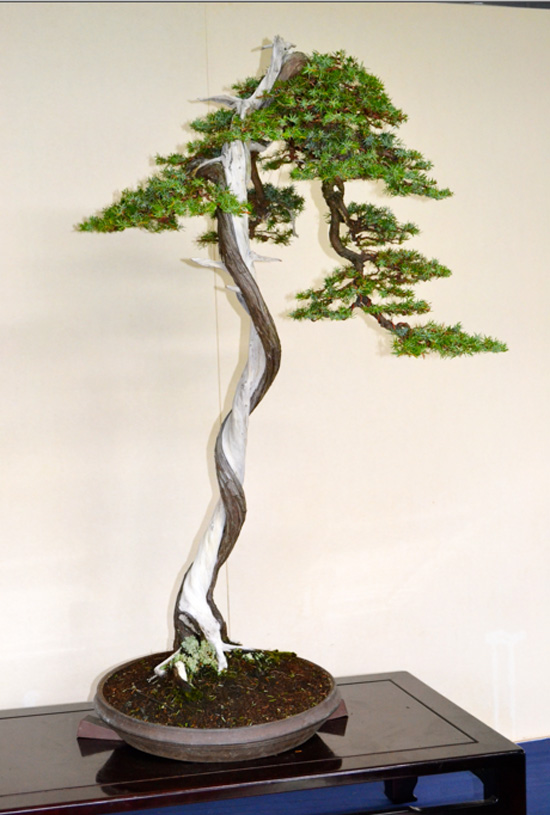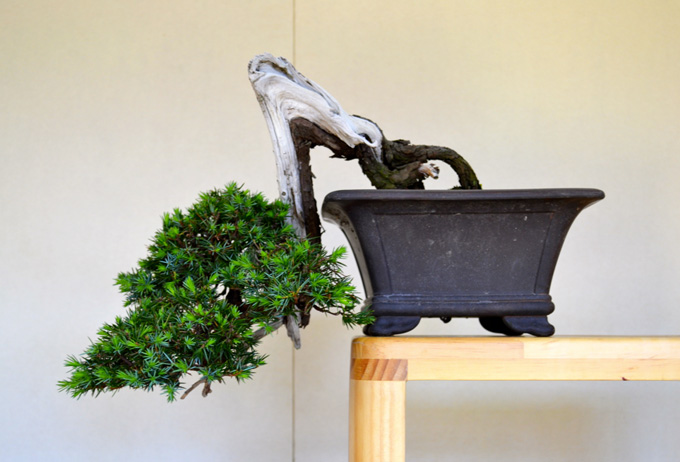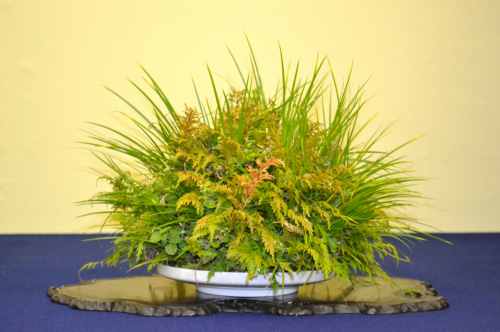 This photo is originally from the from Kokufu-ten 47 (1973) and came to us via Owen Reich’s Bonsai Unearthed. We’ve been discussing root-on-rock bonsai lately, and by extension root-over-rock bonsai, and you must admit that this is a worthy and very unusual example of the latter (I’ll guess that it’s a Trident maple). Also, when have you ever seen a companion plant quite as large as this one?
This photo is originally from the from Kokufu-ten 47 (1973) and came to us via Owen Reich’s Bonsai Unearthed. We’ve been discussing root-on-rock bonsai lately, and by extension root-over-rock bonsai, and you must admit that this is a worthy and very unusual example of the latter (I’ll guess that it’s a Trident maple). Also, when have you ever seen a companion plant quite as large as this one?
It’s about time we featured Owen Reich (an apprentice and instructor in Japan whose name came up in our last post). After all, it’s rare to find someone who knows his (or her) way around a bonsai and can also write. Really. I’ve read and even edited miles of bonsai writing, and no offense to absolutely anyone, but if as many people who think they can write, could really write, then the world would be full of Faulkners* or Nabokovs or…. (your choice here). And, though it’s all too easy to imagine your next thought, you’ll have to admit that it’s not for lack of trying.
Back to Owen and his blog. My only complaint is that he doesn’t post more often, though I get that he’s a busy man with styling and taking care of bonsai, traveling, teaching and all the rest… so I guess we’ll take what we can get. Which happens to include great trees, exceptional kusamono and this… “As I type this I’m surrounded by bonsai containers, scrolls, stands, tools, and about 200 pounds of books. Time to jettison most of my clothing and other “non-essential” cargo and head back to America. My Cultural Studies VISA ends a few days after the Taikan-ten and I’ll be back in America to teach for most of 2013. Much like extra-terrestrials, I’ll be appearing in front of small groups of Southerners most of the time but sightings of me will occur all over America with international trips in the works. My apprenticeship is far from over.”
*Speaking of Faulkner, it might be worth mentioning that Owen is a Southerner, which could help explain his penchant for story telling.
 Blood, Sweat and Tosho is one of Owen’s many well-worth-the-time-to-read posts about this Needle juniper that he styled for a client in Japan.
Blood, Sweat and Tosho is one of Owen’s many well-worth-the-time-to-read posts about this Needle juniper that he styled for a client in Japan.
 Battling some Needle Junipers and Bonsai Friends. Another Needle juniper that appears in yet another enjoyable and instructive post on Owen’s blog.
Battling some Needle Junipers and Bonsai Friends. Another Needle juniper that appears in yet another enjoyable and instructive post on Owen’s blog.
Sweet Tea and Yamadori Here I Come! An unidentified tree that appears on Owen’s blog. Though the title says Sweet Tea, still, based on the leaves, I’d swear it’s a Camellia. Will I be shown the fool once again?
 Kusamono of Taikan-ten 2011. You don’t usually see Kusamono this lush.
Kusamono of Taikan-ten 2011. You don’t usually see Kusamono this lush.

Look at the date of the first photo: 1973, forty years ago. I wouldn’t mind betting that there have been very few new root-over-rock bonsai produced since then, certainly not in the past decade or two. It seems all the training these days is focused on manipulating any given piece of coniferous yamadori into one of a very narrow range of acceptable silhouettes. I have a few ideas why. Anyone else?
The tea you drink indeed does come from the camellia plant! It is primarily made from one or two species I think. You can make tea from Sassanqua camellia though, evidently.
Colin,
I’m not sure what is meant by your post. There have been many root-over-rock bonsai produced since 1973. The first tree is deciduous so the second half of your post referencing coniferous yamadori must be in regards to a different picture maybe? Styles in the art world ebb and flow and trends develope, become the norm, and then morph into new designs and trends. The art world is very dynamic in that way. Sometimes the changes are very gradual and take many years to progress. Other times a new design or form can seem to happen overnight and turn the art world upside down. I guess the dynamic nature and individuality of art is part of what keeps us all interested and engaged. I know Nick Lenz has some very interesting root-over-rock designs. He also has a root-over-tank, root-over-statue, and root-over-ruins design that are each really cool. (at least in my opinion) Harry Harrington has a pretty informative root-over-rock mame progression on his bonsai4me.com site as well. I have four root-over-rock compositions that I’m developing in my own collection. Root-over-rocks are certanly out there and are being developed with some regularity. They are just a little more of a time investment than some other styles.
Colin,
You have some amazing trees by the way. Very emotive.
Not to be “pesky,” but the author’s name is Nabokov.
Carolyn,
Must be this old keyboard…
Still, you’re hired!
Hello Bio Guy,
Just to set the record straight, Colin commented on this post, but is in no way responsible for the post. Bonsai Bark is my doing, for better or worse.
Further, the trees shown here are not Colin’s (though he does have some amazing trees), nor or they mine (not so amazing as it turns out). They are all images I borrowed (and attributed whenever possible).
Wayne, thanks for the plug. The photo above is a Camellia japonica I styled last Fall. I’ll have a post on it eventually and am currently writing a number of other posts. Lots more time in airport terminals this summer (like now). Always enjoy reading Bonsai Bark :).
Tea is generally produced from Camellia sinensis but can be made from C. oleifera as well. http://en.wikipedia.org/wiki/Camellia_sinensis
That companion plant looks capable of advancing across the table to attack the bonsai tree, who is running up the rock to escape it….wonder what plant it is, and how it is emotive of winter.
Hi Judy,
Ha. Good point.
I don’t know what it is, but I guess the reddish color could be construed as winterish.
The kusamono in the old photo is Gaultharia procumbens. Four seasons of interest.